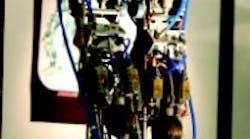It has been more than 30 years since Lee Majors made his debut on TV as the Six Million Dollar Man — a NASA test pilot critically injured and then reconstructed using nuclear powered limbs and assorted bionic parts. And although we have certainly made huge strides in prosthetics in the past 30 years, one might question how much closer we are to bionic limbs.
Although truly bionic limbs are probably mere fantasy for the foreseeable future, some interesting projects from the Robotics & Multibody Mechanics Research Group at Vrije Universiteit Brussel in Belgium suggest that pneumatics may someday play a role in such a design.
Getting pumped up
Pneumatic Artificial Muscles are contractile devices operated by pressurized air — essentially a bellows that will contract when inflated. The contraction force and displacement they generate can be used to power machine parts, robots, exoskeletons, prosthetic limbs, etc.
Pleated Pneumatic Artificial Muscles (PPAMs) were developed at Vrije Universiteit Brussel in an effort to create an actuator for a bipedal walking robot. This led to a design with a longer contraction range, no stick-slip or friction, and an enormous force output.
The improvements result from the way the inflation and contraction are obtained. As indicated by the name, the folding of the pleats is important. When it is not inflated, the PPAM looks like a car engine air filter. The muscle is hollow inside, and the bellow is a pleated membrane; within each pleat is kevlar fiber, to carry the high forces generated. When inflated, the membrane expands radially and contracts axially as it unfolds. No rubber-like material strain or friction is involved in this process, as with other devices.
Because of its design, the PPAM produces high force-to-weight and power-to-weight ratios. The generated force for a muscle 10-cm long and weighing only 70 grams exceeds 3000 N. This force is carried by polymer fibers embedded in the bellows.
PPAMs have a natural and controllable compliance, making them suited for biologically inspired applications where spring-like behavior and energy storage play an important role. Because of their compliance, they can easily withstand shock loads. In addition, they are directly connected to the joint they drive, meaning no speed reduction is necessary, as would be the case for electrical drives. Using PPAM drives is actually comparable to a muscle-tendon-bone connection.
Lucy struts her stuff
The Robotics & Multibody Mechanics Research Group integrated their actuators into a bipedal walking robot dubbed Lucy. Lucy is a robot with six degrees of freedom: ankle, knee, and hip for each leg. Each joint is actuated by an opposing pair of PPAMs.
All pneumatics and control electronics are on-board, except for the main control unit, which is implemented on a PC. The PPAMs typically use a pressure range of 0 to 3 bar — relatively low compared to other types of artificial pneumatic muscles. Lucy was designed to walk in the sagittal plane (a vertical plane through the longitudinal axis dividing the body into left and right portions) and to investigate dynamically stabilized walking. In just one year, Lucy can already walk in a statically stabilized way — the center of gravity is always above a supporting foot. Current research is focusing on having Lucy walk in a dynamically balanced way, as humans do.
According to Prof. Dirk Lefeber, "These muscles are potential actuators for artificial legs. In this context, we recently started research on an intelligent ankle-foot prosthesis with adaptable compliance." Lefeber also notes an additional project dealing with the development of a step rehabilitation robot. Details on these projects can be found at mech.vub.ac.be/ multibody/research_topics.htm.
Well armed
The research team has also designed an arm (at left), operated by two pairs of muscle groups. Each extender group has four PPAMs in series, each flexor group three. This allows for a large operating range — 1.5 m in the forward direction, 1.5 m vertically, and a free rotation of the base in the horizontal plane. The arm, which weighs 25 kg, is designed for payloads of up to 50 kg. Lefeber explains they have built a 1/3 scale model and are doing research on its control. Eventually, a basic controller will enable fingertip control to move the arm in its working space. In this way, it could serve as an ergonomical system that relieves people of heavy loads. The operator only provides a small directive force while the arm lifts a weight and follows the operator instructions.




